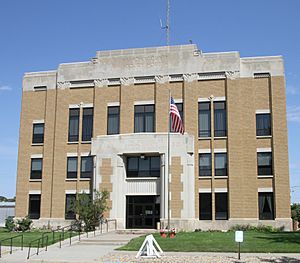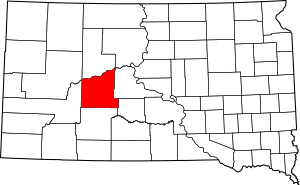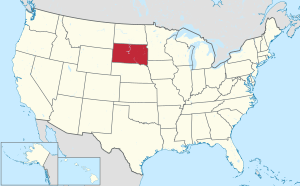Haakon County, South Dakota facts for kids
Quick facts for kids
Haakon County
|
|
|---|---|

Haakon County Courthouse in Philip
|
|

Location within the U.S. state of South Dakota
|
|
 South Dakota's location within the U.S. |
|
| Country | |
| State | |
| Founded | 1914 (created) 1915 (organized) |
| Named for | Haakon VII of Norway |
| Seat | Philip |
| Largest city | Philip |
| Area | |
| • Total | 1,827 sq mi (4,730 km2) |
| • Land | 1,811 sq mi (4,690 km2) |
| • Water | 16 sq mi (40 km2) 0.9% |
| Population
(2020)
|
|
| • Total | 1,872 |
| • Estimate
(2023)
|
1,851 |
| • Density | 1.0246/sq mi (0.39561/km2) |
| Time zone | UTC−7 (Mountain) |
| • Summer (DST) | UTC−6 (MDT) |
| Congressional district | At-large |
Haakon County is a county in the U.S. state of South Dakota. As of the 2020 census, the population was 1,872. Its county seat is Philip.
Contents
History
The county was created in 1914 and organized in 1915, and was formed from the original counties of Nowlin and most of Sterling, which had previously been absorbed by Stanley County. It is named for Haakon VII, who became king of Norway in 1905, in order to attract Norwegian settlers to the county. It is the only county in South Dakota named for a non-American person and is one of only nine counties in South Dakota named for persons who did not live in South Dakota. Most of South Dakota's counties are named for early South Dakota officials or legislators, or for physical features (Fall River and Lake), or are derived from Native American words (Minnehaha and Yankton), or from counties in other states (Jones and Walworth), with one (Aurora) named for a Roman goddess, one for an animal (Buffalo), and one (Union) for a concept.
Geography
The terrain of Haakon County consists of semi-arid rolling hills, carved with gullies and drainages, partially devoted to agriculture. The Cheyenne River, a tributary of the Missouri River, flows northeastward along the county's north boundary line, and the Bad River flows east-northeastward through the lower part of the county, both heading for their discharge points into the Missouri. The terrain slopes to the northeast, and its highest point is near the midpoint of its western boundary line, at 2,802 ft (854 m) ASL.
Haakon County has a total area of 1,827 square miles (4,730 km2), of which 1,811 square miles (4,690 km2) is land and 16 square miles (41 km2) (0.9%) is water.
The eastern portion of South Dakota's counties (48 of 66) observe Central Time; the western counties (18 of 66) observe Mountain Time. Haakon County is the easternmost of the SD counties to observe Mountain Time.
Major highways
Adjacent counties
- Ziebach County - north
- Stanley County - east
- Jones County - southeast (observes Central Time)
- Jackson County - south
- Pennington County - west
Protected areas
- Billsburg State Game Production Area
- Cheyenne State Game Production Area (part)
Lakes
Source:
- Waggoner Lake
Demographics
| Historical population | |||
|---|---|---|---|
| Census | Pop. | %± | |
| 1920 | 4,596 | — | |
| 1930 | 4,679 | 1.8% | |
| 1940 | 3,515 | −24.9% | |
| 1950 | 3,167 | −9.9% | |
| 1960 | 3,303 | 4.3% | |
| 1970 | 2,802 | −15.2% | |
| 1980 | 2,794 | −0.3% | |
| 1990 | 2,624 | −6.1% | |
| 2000 | 2,196 | −16.3% | |
| 2010 | 1,937 | −11.8% | |
| 2020 | 1,872 | −3.4% | |
| 2023 (est.) | 1,851 | −4.4% | |
| U.S. Decennial Census 1790-1960 1900-1990 1990-2000 2010-2020 |
|||
2020 census
As of the 2020 census, there were 1,872 people, 773 households, and 510 families residing in the county. The population density was 1.0 inhabitant per square mile (0.39/km2). There were 931 housing units.
2010 census
As of the 2010 census, there were 1,937 people, 850 households, and 540 families in the county. The population density was 1.1 inhabitants per square mile (0.42/km2). There were 1,013 housing units at an average density of 0.6 per square mile (0.23/km2). The racial makeup of the county was 94.7% white, 1.9% American Indian, 0.4% Asian, 0.2% black or African American, 0.1% Pacific islander, 0.2% from other races, and 2.6% from two or more races. Those of Hispanic or Latino origin made up 0.9% of the population. In terms of ancestry, 45.4% were German, 19.4% were Irish, 17.6% were Norwegian, 8.6% were English, 6.2% were Czech, 5.1% were Dutch, and 1.2% were American.
Of the 850 households, 23.8% had children under the age of 18 living with them, 56.6% were married couples living together, 4.2% had a female householder with no husband present, 36.5% were non-families, and 33.2% of all households were made up of individuals. The average household size was 2.24 and the average family size was 2.86. The median age was 48.8 years.
The median income for a household in the county was $46,281 and the median income for a family was $60,000. Males had a median income of $37,679 versus $22,277 for females. The per capita income for the county was $25,877. About 13.2% of families and 12.5% of the population were below the poverty line, including 14.9% of those under age 18 and 13.7% of those age 65 or over.
Housing cost
In 2007, the average price (in US dollars) for housing was:
- Single family home: $143,052
- Town homes and other attached homes: $116,019
- Twin homes: $176,744
- Mobile homes: $51,477
Communities
Towns
Unincorporated communities
Source:
- Billsburg
- Kirley
- Milesville
- Nowlin
- Ottumwa
- West Fork
Unorganized territories
- East Haakon
- West Haakon
See also
 In Spanish: Condado de Haakon para niños
In Spanish: Condado de Haakon para niños

